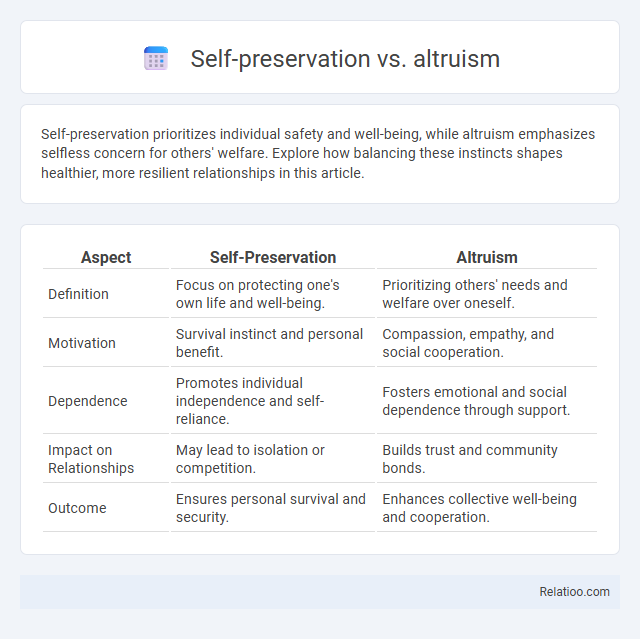Self-preservation prioritizes individual safety and well-being, while altruism emphasizes selfless concern for others' welfare. Explore how balancing these instincts shapes healthier, more resilient relationships in this article.
Table of Comparison
| Aspect | Self-Preservation | Altruism |
|---|---|---|
| Definition | Focus on protecting one's own life and well-being. | Prioritizing others' needs and welfare over oneself. |
| Motivation | Survival instinct and personal benefit. | Compassion, empathy, and social cooperation. |
| Dependence | Promotes individual independence and self-reliance. | Fosters emotional and social dependence through support. |
| Impact on Relationships | May lead to isolation or competition. | Builds trust and community bonds. |
| Outcome | Ensures personal survival and security. | Enhances collective well-being and cooperation. |
Understanding Self-Preservation
Understanding self-preservation involves recognizing the instinctual drive to protect your own safety and well-being above all else. This survival mechanism prioritizes your health and security, often influencing decisions in critical situations. Balancing self-preservation with altruism requires awareness of when to protect yourself and when to extend help to others without compromising your own stability.
Defining Altruism
Altruism involves acting out of genuine concern for the well-being of others, often at a personal cost, distinguishing it from self-preservation which prioritizes one's own survival and interests. In biological and psychological contexts, altruism is defined by behaviors that benefit others without direct personal gain, highlighting empathy and social bonding. Understanding altruism helps you recognize the balance between caring for yourself and contributing to the welfare of those around you.
The Evolutionary Roots of Self-Preservation
Self-preservation, deeply rooted in evolutionary biology, drives organisms to prioritize survival by avoiding threats and securing resources, ensuring gene propagation. Altruism, while seemingly counter to self-preservation, can enhance genetic fitness through cooperation and reciprocal behaviors observed in social species. Evolutionary theories like kin selection and inclusive fitness explain how altruistic acts contribute to an individual's overall genetic success alongside self-preserving instincts.
Psychological Foundations of Altruism
Psychological foundations of altruism reveal intrinsic motivations rooted in empathy, social bonding, and evolutionary advantages promoting group survival. Altruistic behavior often arises as a balance between self-preservation and the desire to enhance others' well-being, supported by neural mechanisms like mirror neurons and oxytocin release. Understanding these foundations allows you to recognize how altruism serves both individual and collective psychological health.
Balancing Self-Interest and Compassion
Balancing self-interest and compassion requires recognizing the importance of self-preservation while valuing altruistic actions that benefit others. You must cultivate empathy alongside practical decision-making to ensure your well-being does not overshadow the needs of those around you. Effective balance promotes personal growth and strengthens social connections, fostering a harmonious coexistence between individual and collective welfare.
Moral Dilemmas: Choosing Between Self and Others
Moral dilemmas involving self-preservation versus altruism challenge individuals to balance protecting their own well-being against the needs of others, often highlighting conflicting ethical principles such as utilitarianism and deontology. Studies in psychology reveal that decisions in high-stakes scenarios depend on factors like empathy, social norms, and perceived consequences, emphasizing the complexity of moral judgment. Neuroscientific research identifies brain regions like the prefrontal cortex as critical in mediating choices between self-interest and prosocial behavior, underscoring the biological basis of moral conflict resolution.
Social Influences on Altruistic Behavior
Social influences play a crucial role in shaping altruistic behavior, often guiding individuals to prioritize others' needs over their own self-preservation instincts. Group norms, cultural values, and social rewards encourage prosocial actions by fostering empathy and reinforcing cooperative behavior. Understanding these social dynamics can help you cultivate altruism, balancing self-preservation with the well-being of your community.
Benefits and Drawbacks of Self-Preservation
Self-preservation ensures your survival by prioritizing personal safety, health, and well-being, providing a stable foundation for pursuing long-term goals. However, excessive focus on self-preservation can lead to isolation, missed opportunities for meaningful connections, and a lack of empathy towards others. Balancing self-preservation with altruism fosters both individual resilience and social harmony.
The Impact of Altruism on Well-being
Altruism significantly enhances well-being by fostering positive social connections and increasing feelings of purpose and fulfillment. Studies reveal that engaging in altruistic behaviors triggers the brain's reward system, releasing endorphins and reducing stress hormones. This contrast with pure self-preservation highlights that altruism not only benefits others but also promotes mental and physical health for individuals.
Navigating Modern Life: Integrating Self-Preservation and Altruism
Balancing self-preservation and altruism is essential for navigating modern life, where individual well-being and social responsibility coexist. Effective integration involves recognizing personal boundaries while fostering empathy, ensuring sustainable support for others without compromising one's own needs. This dynamic approach enhances emotional resilience and community cohesion, optimizing both personal growth and societal well-being.

Infographic: Self-preservation vs Altruism
 relatioo.com
relatioo.com